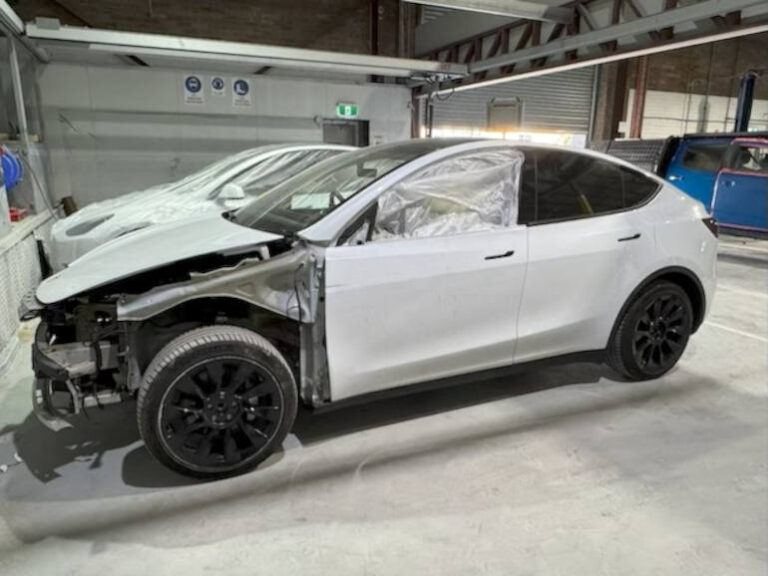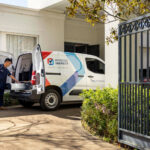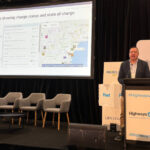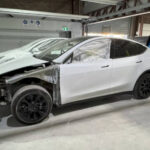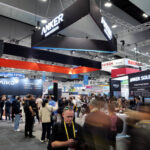Electric vehicles are not only changing the way fleets power their vehicles – they are also reshaping the panel repair industry. New safety requirements, longer repair times, and higher costs mean Fleet Managers need to think differently about accident management as EV adoption grows.
Safety is non-negotiable
According to Shaun Janks, Co-Founder and Chief DingGo at DingGo, the biggest change is safety.
“If you put your hand in the wrong place before you’ve powered down the battery, you’re dead,” Mr Janks said. “Repairers have to learn the process of making an EV safe before pulling panels or removing linings. It’s life or death.”
To manage the risk, many repairers have created EV-only bays and trained specific staff to handle high-voltage vehicles. “The first bit of training everyone went through was safety – knowing how to power down the car before anything else,” he explained.
Repairs take longer
Even when damage is only cosmetic, the repair process takes more time with EVs.
“It’s about 20 per cent longer to repair an EV,” Mr Janks said. “That extra time comes from powering down, recalibrating ADAS systems afterwards, and even things like lifting the car onto hoists because of the extra battery weight.”
For Fleet Managers, that means factoring longer downtime into replacement planning and service level agreements with repairers.
Higher repair costs
The added labour translates into higher costs. DingGo’s data shows EV repairs are around 20 per cent more expensive on average than ICE vehicles.
“EVs are usually involved in less severe accidents, more cosmetic in nature,” Mr Janks said. “But even then, the average cost is higher. I’d hate to think what happens when an EV is involved in a major accident – the costs would be significantly higher than a comparable ICE vehicle.”
Parts supply challenges
While established brands like Toyota have well-developed parts networks, many EV brands are still building their supply chains in Australia. That creates extra delays.
“Some of the new OEMs are dumping cars into the market faster than they’re building aftermarket support,” Mr Janks said. “Panel shops struggle to get certain parts, particularly battery housings and structural components. Even simple things like pillars can be hard to source.”
For Fleet Managers, this means asking OEMs about local parts supply and factoring in the risk of longer vehicle downtime.
Common damage types remain the same
Although the repair process differs, the types of accidents are familiar. DingGo’s data shows front-end damage accounts for 26 per cent of incidents, doors for 17 per cent, and rear-end hits 13 per cent.
“Most repairs are still the usual bumpers, headlights and panels,” Mr Janks said. “It’s just that when it’s an EV, the safety and repair process around it is very different.”
Safer vehicles, but pricier repairs
The positive news is that EVs appear to be safer on the road. “We’re seeing a 19 per cent lower incident rate for EVs compared with ICE vehicles,” Mr Janks said. “They also tend to be involved in lower-severity accidents. The ADAS technology built into EVs is clearly playing a role.”
That means fleets may see fewer repairs overall, but when they do happen, they are likely to cost more and take longer.
What Fleet Managers should do
Mr Janks advised Fleet Managers to look beyond the purchase price when planning EV adoption.
“Fleets need to think about the support behind the vehicle – who can repair it, how quickly parts can be sourced, and how safe the repair process is,” he said.
For Fleet Managers, the key steps are:
- Check repairer capability – ensure your network is EV-certified.
- Plan for longer downtime – EVs take more time to repair.
- Factor in higher costs – include repair costs in whole-of-life models.
- Reduce accidents – invest in driver training, ADAS awareness, and telematics.
The shift to EVs is unavoidable, but with the right preparation, fleets can manage the risks. As Mr Janks summed up: “EVs are safer and involved in fewer accidents, but when they are damaged, repairs take longer and cost more. Fleet Managers need to plan for that balance.”
- RedBook Inspect Launches EV Battery Health Tests to Boost Confidence in Used EVs
 A new inspection service from RedBook Inspect aims to bring clarity, transparency and confidence to the growing used electric vehicle market. RedBook Inspect, part of carsales, has launched a new Electric Vehicle (EV) battery health testing service to help buyers and dealers better understand the condition of high-voltage batteries — the most expensive and critical component in
A new inspection service from RedBook Inspect aims to bring clarity, transparency and confidence to the growing used electric vehicle market. RedBook Inspect, part of carsales, has launched a new Electric Vehicle (EV) battery health testing service to help buyers and dealers better understand the condition of high-voltage batteries — the most expensive and critical component in - How Fleets Can Navigate the Transition to Battery Electric Vehicles with Data-Driven Confidence
 At Mobility Live 2025 in Sydney, David Brown, Associate Vice President of Sales – APAC at Geotab, shared how fleets can make practical, data-driven decisions when transitioning to battery electric vehicles (BEVs). Rather than framing electrification as a leap of faith, Brown positioned it as an opportunity that can be guided by insight, not guesswork. “If I’m a Fleet
At Mobility Live 2025 in Sydney, David Brown, Associate Vice President of Sales – APAC at Geotab, shared how fleets can make practical, data-driven decisions when transitioning to battery electric vehicles (BEVs). Rather than framing electrification as a leap of faith, Brown positioned it as an opportunity that can be guided by insight, not guesswork. “If I’m a Fleet - EVs Spark a Change in the Panel Repair Industry
 Electric vehicles are not only changing the way fleets power their vehicles – they are also reshaping the panel repair industry. New safety requirements, longer repair times, and higher costs mean Fleet Managers need to think differently about accident management as EV adoption grows. Safety is non-negotiable According to Shaun Janks, Co-Founder and Chief DingGo
Electric vehicles are not only changing the way fleets power their vehicles – they are also reshaping the panel repair industry. New safety requirements, longer repair times, and higher costs mean Fleet Managers need to think differently about accident management as EV adoption grows. Safety is non-negotiable According to Shaun Janks, Co-Founder and Chief DingGo - Showcasing the iGreen Charging Solution for Fleet Depots
 At All Energy Australia 2025, Autel showcased its iGreen Charging Solution — a one-stop intelligent platform integrating PV, ESS, EVSE, EMS, and CSMS. The system combines hardware such as the MaxiCharger DC Series and Battery Energy Storage System (BESS) with Autel’s own energy management and control software, providing a complete depot electrification solution for operators scaling EV fleets. Key highlights include: Together, these components form
At All Energy Australia 2025, Autel showcased its iGreen Charging Solution — a one-stop intelligent platform integrating PV, ESS, EVSE, EMS, and CSMS. The system combines hardware such as the MaxiCharger DC Series and Battery Energy Storage System (BESS) with Autel’s own energy management and control software, providing a complete depot electrification solution for operators scaling EV fleets. Key highlights include: Together, these components form - Anker Showcases Complete Smart Energy Ecosystem at All Energy Australia 2025
 Global technology leader Anker Innovations made a strong impression at All Energy Australia 2025, presenting its most comprehensive multi-brand lineup yet — connecting power, storage, charging, and smart living in one integrated ecosystem. Since launching in 2011, Anker has grown into one of the world’s most trusted names in mobile charging and smart energy. Its brands are now
Global technology leader Anker Innovations made a strong impression at All Energy Australia 2025, presenting its most comprehensive multi-brand lineup yet — connecting power, storage, charging, and smart living in one integrated ecosystem. Since launching in 2011, Anker has grown into one of the world’s most trusted names in mobile charging and smart energy. Its brands are now


